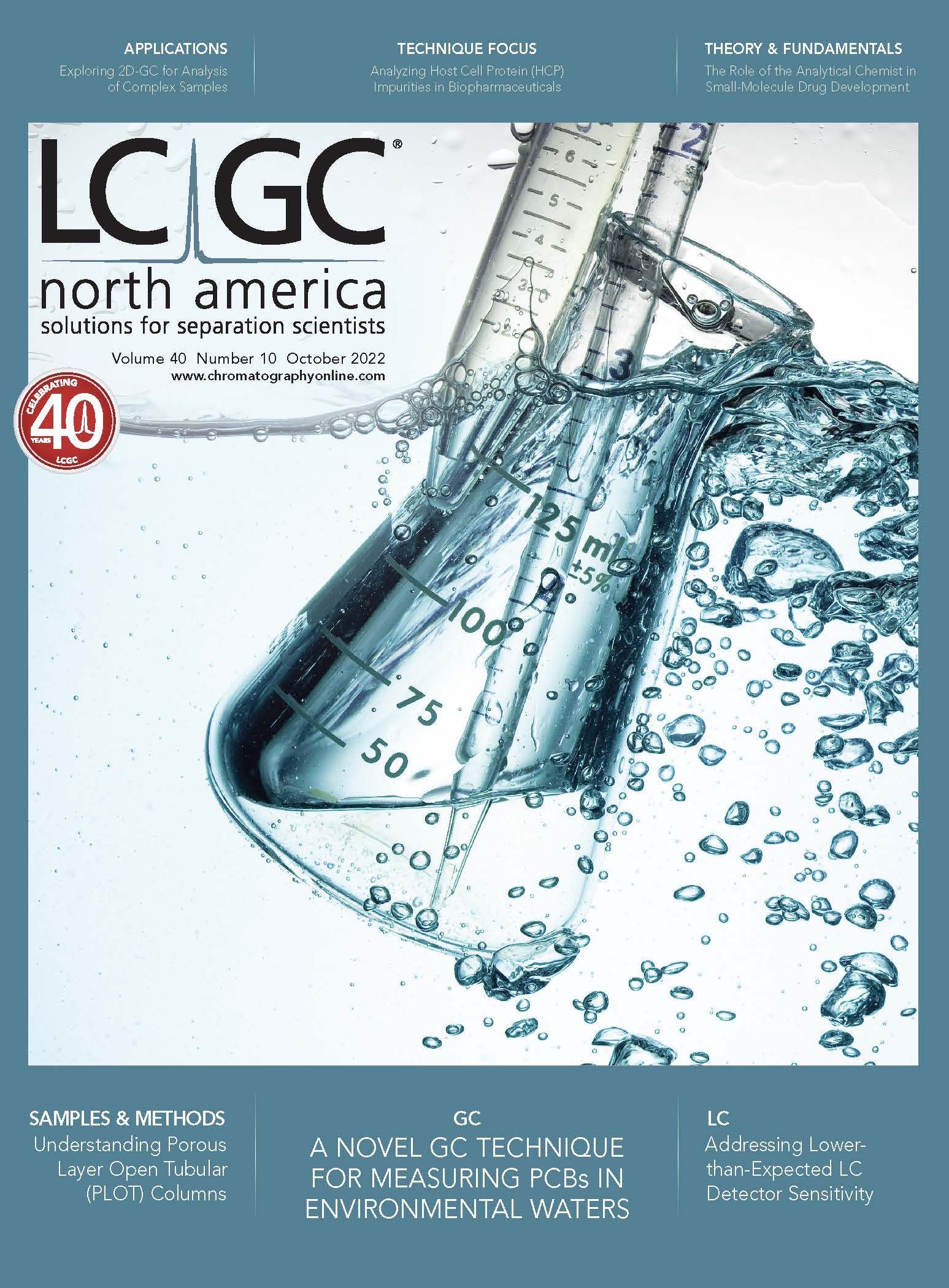Analytical Characterization of Host Cell Proteins (HCPs)
Biotechnology products such as biopharmaceuticals, including biosimilars, are produced in living organisms or cells. A common phrase that we hear is “the process is the product.” Thus, this process of producing these products in living organisms presents several unique challenges to consider. One of those key challenges is the characterization of not only the product itself, but other impurities in the form of host cell proteins (HCPs) that may be present. To ensure that these HCPs do not have clinical implications, it is important to understand what they are. Therefore, in this column, we take a closer look at specific analytical technologies and tools to analyze these host cell proteins, with a specific focus on liquid chromatography (LC) and mass spectrometry (MS) approaches.
Biopharmaceuticals, unlike small molecules, are manufactured using living cells, such as Chinese hamster ovary (CHO) cells. The active pharmaceutical ingredient (API) is produced in cells such as CHO cells using recombinant DNA technology, which allows for the production of large amounts or quantities of the respective APIs. As the desired API is being manufactured by living cells, these cells are going through their normal cellular life cycle and processes; that is to say, they are still producing their own macromolecules, such as nucleotides, lipids, carbohydrates, and proteins, to stay alive. These host cell macromolecules, including host cell proteins (HCPs), are considered impurities, and should be removed to ensure product quality, safety, and efficacy from the drug product (1–4).
Nearly two-thirds of biopharmaceutical drug shortages are because of quality issues during the manufacturing process, including the presence of host cell proteins (5). HCPs and other impurities can affect product quality, safety, and efficacy in numerous ways, which is why they need to be reduced or removed from drug products. One of the most prominent concerns with HCPs is immunogenicity. Residual HCPs are foreign objects to our immune systems; thus, they could cause an immune response (immunogenicity). HCPs also may be proteases or proteins that have proteolytic activity, which can cause biologics such as monoclonal antibodies (mAbs) to be cleaved into fragments, thus reducing product yield and activity. HCPs with catalytic activity can also cause leaching of protein A from protein A columns (for example, cleaving protein A and releasing fragments into the purified product). Protein A causes a detrimental immune response. Also, HCPs could cause protein aggregation of the biologically active pharmaceutical ingredient, thus reducing its yield and activity (2).
Host Cell Proteins As a Critical Quality Attribute
An important part of quality by design (QbD) is defining critical process parameters (CPPs) and critical quality attributes (CQAs). A critical process parameter is a parameter that can affect the quality of the product. Critical quality attributes are physical, biological, chemical, or microbiological characteristics that should be monitored, and they fall within a specific limit, range, or distribution (6). For drug products, CQAs may include degradation products, post-translational modifications, and host cell proteins.
Often times, CQAs are described in the context of the drug substance (API), and changes that may occur to it. For example, changes to post-translational modifications such as glycosylation and charge state variants of a mAb are monitored as CQAs. However, impurities such as HCPs are also important CQAs to monitor to ensure product quality (3).
Host cell proteins can be monitored in both the upstream process and the downstream process. In the upstream process, the characterization of HCPs can give an indication of what host cell proteins may be present throughout the process, such as an abundance of a specific protease or other cellular protein. It can also give an indication of host cell proteins that may be hitchhiking with the APIs through specific or nonspecific binding events. The presence of certain HCPs may inform the downstream purification scheme that is implemented. Monitoring the presence in the downstream purification process can also ensure if adjustments need to be made to the purification process, or suggest alternative approaches to remove these HCPs. Thus, monitoring HCPs is another characterization of the drug substance and product that ensures product quality (3).
Enzyme-Linked Immunosorbent Assay (ELISA) for Characterization of Host Cell Proteins
The enzyme-linked immunosorbent assay (ELISA) has been used as the primary tool for detecting HCPs, largely because of its high throughput, selectivity, and sensitivity. However, there are several limitations to the ELISA method. The antibodies raised against the cell line supernatant or lysate do not always recognize all HCPs present, especially weak and non-immunoreactive HCPs. The development of a suitable ELISA can take several months, if not years, to develop. Limited antibodies to a specific HCP or excess antigen can cause a dilution-depended nonlinearity that prevents proper identification. Also, ELISAs are not able to identify the specific HCP present, but instead just the presence or absence of HCPs and the reduction of their presence through process-related purification (4).
LC–MS/MS for Characterization of Host Cell Proteins
These limitations and others to the use of an ELISA to monitor HCPs are partially the reason for the development of orthogonal techniques to characterize host cell proteins. The key to the development of an orthogonal technique to the ELISA includes, but is not limited to, being able to identify the specific HCP, as well as the need not to have to create a new assay to measure the presence of new HCPs. In addition, as an impurity assay, the method should be able to detect low levels of any given HCP (3).
Over the last several years, regulatory authorities such as the U.S. Food and Drug Administration (FDA) have asked for improved monitoring methods, such as liquid chromatography–mass spectrometry (LC–MS), to characterize HCPs. Interestingly, the FDA and other regulatory authorities (such as the European Medicines Agency), as well as international standard-setting bodies (such as the International Council for Harmonization), do not provide specific numerical limits of the HCP level, as the risk associated with HCP levels are dependent on several factors, including dose and patient population, along with several others. These and other factors are indications that HCP analysis by LC–MS will only increase in the coming years (3).
The term proteomics was first used by Marc Wilkins in 1996, and, for decades, LC has been used for protein separation and purification, and mass spectrometry used for the characterization of proteins within a proteome (7). Thus, proteomic techniques can be used to characterize and monitor HCPs, as it is a “simple” proteomics experiment. Perhaps the greatest advantage to LC–tandem MS (LC–MS/MS) analysis of HCPs is the ability to positively identify and quantify specific HCPs, as well as characterize the total amount of HCPs present, something that an ELISA cannot do. Each specific HCP can be monitored in a high-resolution mass spectrometer without the need for anti-HCP antibodies (3), which allows for the identification of new or previously undetected HCPs to be characterized without the need for developing a new assay. The same LC–MS/MS assay can be used to characterize HCPs across products produced in various cell lines, allowing for faster characterization of the product, which becomes particularly important when developing new biologics to deploy during something like a global pandemic (such as Covid-19). In addition, by knowing the specific identity of the HCP, specific approaches can be developed and employed to remove it from the process, or to remove it as an impurity (3).
As for every experiment, reproducibility is of prime importance, and LC–MS/MS analysis of HCPs is no different, especially as the analysis is comprised of a complex workflow. Briefly, sample preparation includes denaturation, reduction alkylation, and (tryptic) digest of the cell lysate or cell supernatant, creating thousands of peptides (8). The peptides created from the digest are then analyzed using LC–MS/MS to identify the HCP and quantify it. In addition to these steps, proper quality control standards are required to ensure reproducibility, and more sensitive mass spectrometers are likely to give a deeper understanding of the HCP profile (3).
Both data-independent acquisition (DIA) and data-dependent acquisition (DDA) can be used to characterize HCPs. In a DIA experiment, all the peptides present are fragmented by MS/MS analysis, which increases the probability of identification of low abundant peptides or proteins. In a DDA experiment, the instrument selects the peptides for MS/MS fragmentation based on certain thresholds set by the operator (3), usually characterizing 4–10 of the most abundant peaks. DDA experiments may miss peptides or proteins of low abundance; however, by selecting the most intense peaks, the quality of the data, and thus the confidence in the protein identification, is increased. The data produced is then searched in a database to make positive protein identifications. To ensure reproducibility, it is recommended that at least two peptides per protein be identified to state the presence of a specific HCP (3).
A Few Thoughts on Multi-Attribute Method (MAM) for HCP Characterization
The multi-attribute method (MAM) is a method used to monitor critical quality attributes of biological products. It includes the digestion of the drug substance and monitoring sequence coverage of the product, as well as characterization of post-translational modifications (PTMs) on the product. The other aspect of MAM, which is often disregarded, is new peak detection (NPD) (9).
NPD can be used to detect new peaks that are specific to the product, such as new peptides from missed cleav- ages, or the addition of new PTMs. At its core, however, NPD is used to detect impurities in the product. Thus, in theory, NPD could be used to detect new HCPs that are present in the drug product or substance.
Conclusions
Ensuring that safe, effective, and quality products get to patients is of utmost importance. Over the last several years, there has been great momentum gained in supporting a quality by design approach to drug development; that is, ensuring quality is considered from the very beginning of the drug development process (6). This has led to the process of understanding critical process parameters and characterizing critical quality attributes.
Critical quality attributes often are considered attributes that change on the active pharmaceutical ingredient; however, they can also include monitoring changes to the drug product, specifically to impurity profiles. One of those impurity profiles that has become increasingly important to monitor are host cell proteins, as they can lead to adverse effects to patients (3).
Historically, multi-analyte ELISAs have been used to monitor HCPs because of their speed, sensitivity, and high throughput. However, over the last several years, regulatory authorities such as the FDA have asked that orthogonal techniques, such as LC–MS/MS, be included in HCP analysis. LC–MS/MS analysis can allow for the specific identification and quantification of a given HCP, which can inform downstream purification strategies, thus potentially increasing the purity of the drug product (3).
LC–MS/MS analysis of HCPs has only been used since 2005 (3); therefore, there are likely to be significant advances over the coming years, especially with the increased regulatory requirements for LC–MS/MS analysis of HCPs (3). Improvements will likely follow, from new sample preparation methods for proteomic experiments to the development of more advanced high throughput mass spectrometers. In addition, new workflows (such as MAM and others) may play a significant role in HCP analysis is in the future.
References
(1) J. Conner, D. Wechterl, M. Lopez, B. Minshall, R. Prusti, D. Boclair, J. Peterson, and C. Allen, in Biotechnology Entrepreneurship: Starting, Managing, and Leading Biotech Companies, C. Shimasaki, Ed. (Academic Press, London, United Kingdom, 2014), pp. 351–385.
(2) C.H. Goey, S. Alhuthali, and C. Kontoravdi, Biotechnol. Adv. 36(4), 1223–1237 (2018).
(3) K. Pilely, M.R. Johansen, R.R. Lund, T. Kofoed, T.K. Jorgensen, L. Skriver, and E. Mortz, Anal. Bioanal. Chem. 414(2), 747–758 (2022).
(4) J. Zhu-Shimoni, C. Yu, J. Nishihara, R.M. Wong, F. Gunawan, M. Lin, D. Krawitz, P. Liu, W. Sandoval, and M. Vanderlaan, Biotechnol. Bioeng. 111(12), 2367–2379 (2014).
(5) A.C. Fisher, M.H. Kamga, C. Agarabi, K. Brorson, S.L. Lee, and S. Yoon, Trends Biotechnol. 37(3), 253–267 (2019).
(6) L.X. Yu, G. Amidon, M.A. Khan, S.W. Hoag, J. Polli, G.K. Raju, and J. Woodcock, AAPS J. 16(4), 771–783 (2014).
(7) B. Aslam, M. Basit, M.A. Nisar, M. Khurshid, and M.H. Rasool, J. Chromatogr. Sci. 55(2), 182–196 (2017).
(8) A. Shevchenko, H. Tomas, J. Havlis, J.V. Olsen, and M. Mann, Nat Protoc. 1(6), 2856–2860 (2006).
(9) J. Auclair and A.S. Rathore, LCGC North Am. 39(1), 28–32 (2021).
ABOUT THE AUTHOR
Jared Auclair is the Vice Provost of Research Economic Development and Director of Bioinnovation at Northeastern University, in Boston, Massachusetts.

ABOUT THE COLUMN EDITOR
Anurag S. Rathore is a professor in the Department of Chemical Engineering at the Indian Institute of Technology in Delhi, India.


Accelerating Monoclonal Antibody Quality Control: The Role of LC–MS in Upstream Bioprocessing
This study highlights the promising potential of LC–MS as a powerful tool for mAb quality control within the context of upstream processing.

.png&w=3840&q=75)

.png&w=3840&q=75)



.png&w=3840&q=75)



.png&w=3840&q=75)











